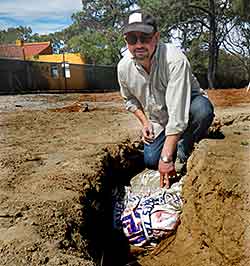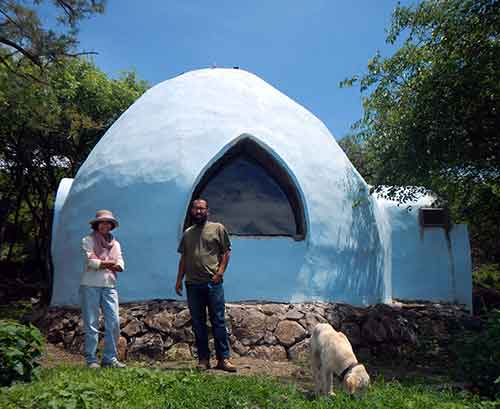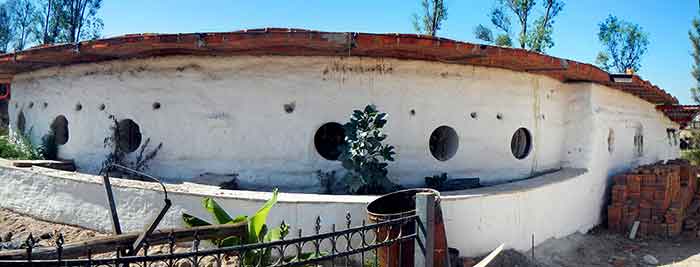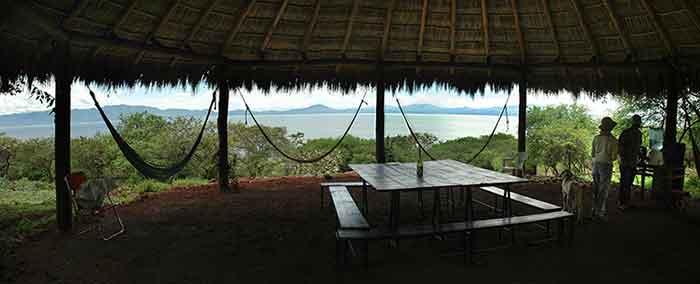|
By John Pint
Pepe Herrera is a good
dentist and as such usually distracts me from
dental discomfort by talking about subjects he knows I’ll find
interesting. “This weekend,” he said, while taking an impression of my
teeth (the few that remain) I’m working on a new project at my rancho.
I’m building my own house out of Superadobe.”

Somehow I managed to
mumble the question, “Wad iz Fooper-um-dob-um?” And
I must say, the answer was fascinating.
Superadobe, Pepe replied, was the idea of Iranian architect
Nader
Khalili for constructing houses on the moon using local materials (in
this case, Moon dust). Khalili demonstrated his technique by showing
refugees in war-torn parts of the world how they could easily build
strong, weather-and-earthquake-proof houses using nothing more than
sacks of sand or dirt mixed with a quantity of cement powder. The gunny
sacks, feed bags or a long polypropylene tube are laid in a shallow
circular trench. One layer is placed upon another, each time using a
slightly smaller diameter, to eventually form an igloo shape. Barbed
wire is laid between each coil to act as both mortar and reinforcement.
The competed structure is then plastered over with a mix similar to
that inside the bags, now called earthbags.
Well, I visited Pepe's rancho to see for myself the first stages of
building a Superadobe house and then searched the web for fully
completed ones, hopefully somewhere in this area.
 Lo and behold!
I found Igloo Kokolo's page, showing lots of fully
completed and functioning Superadobe constructions right on the shore
of Lake Chapala, halfway between Tuxcueca and Tizapán. We contacted the
owner, Salvador “Chavo” Montaño, who kindly invited us to visit Igloo
Kokolo, located in the middle of “the last tract of virgin land left on
the lakeshore.” Lo and behold!
I found Igloo Kokolo's page, showing lots of fully
completed and functioning Superadobe constructions right on the shore
of Lake Chapala, halfway between Tuxcueca and Tizapán. We contacted the
owner, Salvador “Chavo” Montaño, who kindly invited us to visit Igloo
Kokolo, located in the middle of “the last tract of virgin land left on
the lakeshore.”
We headed for the lake and easily found the entrance to the place, just
six kilometers past Tuxcueca. Montaño welcomed us with open arms, took
us on a tour of what seemed like a Pitufo (Smurf) Village of
igloo-shaped houses made of Superadobe, and gave us refreshments under
a large palapa beautifully constructed by experts from Sayulita.
While taking in a stupendous panoramic view of the lake, we learned
that Igloo Kokolo has been principally used over the last few years to
welcome and shelter members of various volunteer organizations and as a
venue for workshops on the following ecologically significant themes:
- Superadobe construction
- Dry Composting Toilets
- Permaculture
- Bici-Máquinas
(bicycle-operated machinery)
- Organic Gardens
Montaño gives the first two of these workshops himself and subcontracts
leading experts for the others. After hearing about Montaño's
involvement in so many fascinating fields, I asked him: “So just what
is Igloo Kokolo after all?”
He gave me a dreamy look. “Igloo Kokolo is really a place for
experimentation in alternative ways to live in equilibrium with our
environment... and with the creatures we find in it. We are learning
through doing, and sharing what we are learning.”
“How do you pay for all this?” was my next question.
In response, Chavo Montaño raised his arms in exasperation. “I don't
know... I really don't know. Maybe I will have to sell part of this
land, but I hate to, because I inherited it from my father and it's
unique. It's really big: 160 hectares, with two kilometers of virgin
waterfront. No tree has ever been chopped down here. The entire
shoreline is rocky and the water's muddy, just the way Mother Nature
made it. I 'd rather see this place preserved as a sanctuary for birds
and animals.”
Chavo Montaño has a long-range plan eventually to rent out some of the
Superadobe houses, but that's not possible at the moment. Camping,
however, is possible and the fee is very reasonable. This would give
you a chance to explore the place and, of course, to test out the
ingenious Dry Composting Toilet as well. Solids and liquids are
cleverly separated at the toilet seat. The former all end up as compost
while, says Montaño, “The urine makes a great liquid fertilizer when
mixed with 9 parts water.” Speaking of water, at Igloo I learned that
in a year I flush away the same amount of water I would normally drink
during 40 years. Wow!
Check out Igloo
Kokolo's web page Here you'll find info
for contacting
Salvador Montaño in case you would like to visit the place. They are
also on Facebook.
Note that you'll need a high clearance vehicle to
drive from the highway to the “Pitufos Village.” You can also park
inside the gate and walk along along a scenic footpath 450 meters long.
You'll find this trail on Wikiloc.com here.
How to get
there
From Guadalajara, take highway 54 toward Colima for about 36 kilometers
and turn off onto highway 15, signposted Morelia or Jocotepec. Go
around to the south side of the lake and head east until you reach
Tuxcueca, which is also the turnoff point for Mazamitla. Set your trip
odometer at zero here and continue east along the lake shore for six
kilometers. On your left you'll see the gate (N20 09.690 W103 07.870)
for Igloo Kokolo, marked with a big sign. Driving time is
just over an hour from Guadalajara and less from Ajijic and Chapala.

A large, nearly
completed Superadobe house in
Fraccionamiento El Roble.

Panoramic view of Lake
Chapala seen from under a huge
Sayulita-style palapa which serves as a workshop and dining hall.
|

